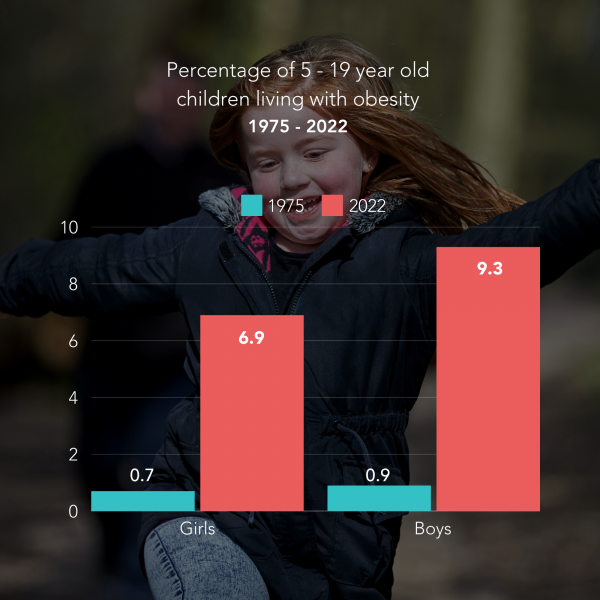Prevalence of Obesity
The worldwide prevalence of obesity has more than tripled between 1975 and 2022. Obesity is now recognised as one of the most important public health problems facing the world today.
In 2024, the NCD Risk Factor Collaboration (NCD-RisC) published findings that estimate that more than one billion people in the world are now living with obesity, nearly 880 million adults and 159 million children and adolescents aged 5-19 years. The World Obesity Federation’s analysis of this data finds that nearly 3 billion people are living with either overweight or obesity. This evidence suggests that most of the world's population lives in countries where overweight and obesity are a bigger risk to health than underweight.
Childhood Obesity
Childhood obesity, in particular, has received noteworthy attention in recent years. According to UNICEF’s estimates, in the year 2000[1] around 30 million children under the age of 5 years were living with overweight or obesity rising to 37 million children in 2022. The NCD-RisC estimates show the prevalence of overweight and obesity among children and adolescents aged 5-19 years to have risen from just 4% in 1975 to almost 20% in 2022.
Over the same time period (1975-2022), obesity rates in 5-19 year olds have increased 10-fold. In 1975, 0.7% of girls were living with obesity compared to 6.9% in 2022 while boys saw an increase from 0.9% to 9.3%. This equates to approximately 65 million girls and 94 million boys living with obesity in 2022 compared to 5 million girls and 6 million boys in 1975. Childhood obesity is linked with a range of adverse physical and mental health outcomes, as well as some negative societal outcomes. That’s why we consider it one of our policy priorities.
Read more

In adults, obesity rates nearly tripled among women (6.6% to 18.5%) and quadrupled in men (3% to 14.0%) between 1975 and 2022. This is the equivalent of approximately 504 million women and 374 million men living with obesity in 2022.
Combined with the 159 million children aged 5-19 years, this is a total of over one billion people affected by obesity alone in 2022. Current projections for overweight and obesity suggest that these trends will continue unless coordinated and evidence-based action is taken – it is clear that the time for action is now.
Our Data
At the World Obesity Federation, we have been collating country-specific prevalence data for over 20 years. This database is freely available for all on our Global Obesity Observatory. See some of the features below.
We have an interactive map that displays measured % obesity prevalence by country and by population breakdowns (age, socioeconomic group, education, region and ethnicity). The interactive map also displays drivers of obesity such as fruit consumption and the prevalence of common comorbidities such as diabetes and obesity-related cancers. You can also find data on economic impact.
You can also view all data we have available for a country (or region!) in one place. Here, you can find data on obesity prevalence, trends, the drivers and comorbidities of obesity (compared to regional countries) and economic impact. All data available for a country/region is downloadable as a report card.
Interactive and customisable data tables for adults and children allow you to view prevalence data in a different format. Tables can be viewed globally or regionally and downloaded as PDFs.
Flat presentation maps show obesity data by region across different decades. Maps can be downloaded as PDFs.
Find here interactive global rankings of estimated obesity prevalence. Rankings table can be downloaded as PDFs.
In the publications section, you can find all of World Obesity's global and regional Atlases. Here, you can also find our reports on economic impact and our policy dossiers.
All are now able to create personal accounts where they can save their favourite graphs, create customised tables, personalise their own PDFs, and more.
Chartbuilder is a feature that allows you to create your own personalised charts that will be saved in your own personal account.
All graphs are downloadable, as are country reports, regional reports, ranking tables, and flat maps.
References:
- NCD Risk Factor Collaboration (NCD-RisC). Worldwide trends in body-mass index, underweight, overweight, and obesity from 1975 to 2016: a pooled analysis of 2416 population-based measurement studies in 128·9 million children, adolescents, and adults. Lancet. 2017;390(10113):2627‐2642. doi:10.1016/S0140-6736(17)32129-3
- NCD RisC Collaboration. Worldwide trends in underweight and obesity from 1990 to 2022: a pooled analysis of 3663 population-representative studies with 222 million children, adolescents, and adults. The Lancet 2024. https://doi.org/10.1016/S0140-6736(23)02750-2
- UNICEF/WHO/World Bank Group Joint Malnutrition Estimates, May 2018 edition
- UNICEF/WHO/World Bank Joint Child Malnutrition Estimates Expanded Database: Overweight (Survey Estimates), May 2023, New York
Causes of obesity
Want to know more about what causes & consequences obesity? Why not check out of next page in 'About Obesity' by clicking the link below.
Causes of obesity